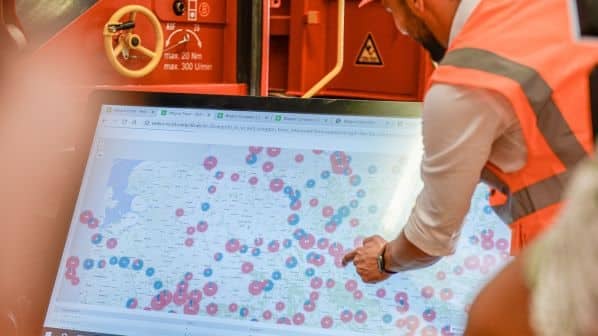GIVING the opening presentation at The Rise of IoT and Big Data in Rail conference, organised by Rotaia Media in Cologne from May 31 to June 1, Mr Rolf Härdi, chief technology information officer at German Rail (DB), made no bones about the scale of the task facing railway and IT professionals as they look to make the best use of the Internet of Things (IoT).
“We have a huge challenge ahead of us,” Härdi said, going on to explain that DB is heavily committed to using the data gathered on rolling stock and infrastructure performance to improve network efficiency and reduce costs as it undertakes a major infrastructure upgrade programme. “We do believe the Internet of Things is our solution. DB is going virtual.”
Looking back on how the use of data in the rail sector has changed, Härdi noted that 20 years ago “the only limit was computing power.” But despite obvious advances in hardware and software, little progress seems to have been made in using the data gathered to deliver positive outcomes. “It’s embarrassing how little we have improved over 20 years,” he said. “We are still failing to effectively use the information that the systems are providing us with. We have to share data.”
He went on to describe how cooperation is one of the four initiatives that DB is implementing under its digital rail programme. Whilst not a strictly contractual relationship, DB has established a legal framework that enables it to share data with its suppliers Siemens, Knorr-Bremse, Wabtec and Alstom. “We share operational data, the supplier shares OEM data, and together we can improve the product," Härdi said.
“We want to make data available and transparent across the disciplines and systems. One of our main objectives is to make the switch to predictive maintenance.”
Mr Mads Throstrup, divisional head of asset management at Banedanmark
Sharing more data internally is also a priority for DB, with technology and data management two further initiatives in its strategy. With 324,442 full-time employees as of June 30 2022, “DB does not know what DB knows,” Härdi said. To share technical knowledge and drive innovation within DB as well as the wider rail sector, over 50 technology communities (TecCos) have been established on specific topics.
Data is also being used to build digital twins, such as a virtual model of a train including its subsystems and components. “Our ultimate goal is to have the entire DB in a virtual environment as a digital twin,” Härdi said. But he emphasised that care must be taken to ensure that the intellectual property of all parties concerned is safeguarded when sharing data.
Breaking out of silos
Mr Mads Throstrup, divisional head of asset management at Banedanmark, gave the Danish infrastructure manager’s perspective on sharing data more widely. “It is our ambition to become more data-driven,” he said. “It is our belief that through a change in maintenance processes and extensive data usage we will be able to get ahead of the lagging maintenance curve.”
As Throstrup explained, the Infrastructure Division of Banedanmark has been organised in silos by engineering discipline, such as bridges, track, catenary or signalling. Working within these silos, engineers have to a certain degree been able to perform data-intensive analysis. Although this analysis is often thorough and deep, it is confined to a specific rail engineering discipline.
”Data is not seen as a common resource,” Throstrup said. “This is a somewhat unclear approach to maintenance at a time when infrastructure needs are not being matched by the funding available,” he said, with the risk of not making the right decisions on maintenance policy and spending.
“We have introduced and developed more cross-disciplinary systems and analysis in order to get a more complete understanding of current infrastructure performance,” Throstrup said. This has included trend analysis of infrastructure faults or “looking in the rearview mirror,” with the extensive data pool of reported incidents used to schedule immediate corrective maintenance work.
“We are changing the way we see data,” Throstrup said. “We want to make data available and transparent across the disciplines and systems. One of our main objectives is to make the switch to predictive maintenance.”
Staying competitive
French National Railways (SNCF) also believes switching to predictive maintenance is necessary if it is to remain competitive in an increasingly open market, according to Mr Guillaume Branger, telediagnostic and predictive maintenance key component engineer at the company’s passenger operating business, SNCF Voyageurs.
Significant advances in fleet performance have already been made with the introduction of Francilien EMUs and the Régiolis and Régio2N regional trains. The number of SNCF trains connected to the IoT is set to grow further as new RER NG EMUs and TGV M high-speed trains roll off the production line.
Branger revealed how the condition of each train and its onboard systems can be displayed in real time on dynamic performance dashboards, enabling maintenance engineers to anticipate a failure and instigate preventive maintenance.
“With the system in operation on 1100 trains for nine years, we are perhaps the only operator to undertake predictive maintenance on this scale,” Branger said. Benefits include a 50% reduction in failures in service, doubling the reliability rate. There has also been a 50% reduction in labour costs, and a 25% reduction in the number of trains out of service for maintenance.
“These savings are really a force for good for us,” Branger said. With the range of predictive maintenance tools still growing, and the possibilities that they offer also increasing, “today is already tomorrow,” he said.

